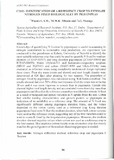Identification of a reference crop to estimate nitrogen fixed biologically by pigeonpeas

View/
Date
2011-09Author
Nkonge, I.G.
Mburu, M.W. K.
Wanderi, S.W.
Language
enMetadata
Show full item recordAbstract
Knowledge of quantifying N fixation by pigeonpeas is useful in assessing its
nitrogen contribution to sustainable crop production. An experiment was
conducted in the greenhouse at Kabete, University of Nairobi to identify the
most suitable reference crop that could be used to quantify N fixed by medium
duration (ICEAP-00557) and long duration pigeonpeas (ICEAP-00040 and
1CEAP-00053). Maize (Hybrid-511 and Katumani-composite), sorghum
(MB30 and IS25545) and cotton (HART-89M and UKA-591l46) were
evaluated as reference crops using completely randomized design replicated
three times. Plant dry mass (roots and shoots) and root length density were
determined at 120 days after planting for two seasons. The proportion of
nitrogen fixed by pigeonpeas was calculated using N-difference method. The
results showed that over 50% of the root biomass of all the crops was at the top
30 em and it was more vigorous in cereals than in pigeonpea. Cereals also
showed higher root length density and accumulated more shoot dry mass than
pigeonpeas and ifused as the reference crops they would underestimate N fixed
as a result of temporal and spatial variation in N uptake from the soil. Cotton
had similar rooting characteristics and growth pattern as pigeonpea an
indication of its suitability as a reference crop. The amount of N fixed was
significantly different among pigeonpea duration types, and the values
depended on the cotton variety used as a reference crop. Long duration
pigeonpeas fixed more N than the medium duration, when both cotton varieties
were used as the reference crops, suggesting any of the two varieties could be
used to assess N fixed by the long duration pigeonpeas. However, the medium
duration showed negative values when cotton was used as a reference crop in
the first season. This implies a cotton variety or an alternative crop that closely
matches the growth pattern ofthe medium duration pigeonpea is needed.
Citation
Optimimization of Agricultural Value Chains for sustainable DevelopmentSponsorhip
National Council of Science and Technology, The Kenya Seed CompanyPublisher
Faculty of Agriculture, University of Nairobi
Description
aGRO 2011 biennial conference presentation
